Home Curriulum Vitae Research Fun stuff Contact
Does tracking increase inequality in performance?
Uploaded 27-12-2019.
The main argument against tracking is that it exacerbates inequality of opportunity. Most importantly, it is thought to increase inequality between pupils with different parental backgrounds (or: socio-economic status). However, also other inequalities between different groups of pupils are considered, namely those caused by migration background, gender and relative age. If I missed a cause of inequality, please inform me (contact@roxannekorthals.com) and I will add it in this overview.
Some papers look at inequality of outcomes, for example H&W (2006), which is not considered here.
Inequality according to socio-economic status (SES)
The most looked at form of inequality is the inequality due to socio-economic status (SES). For adults, the SES if often measured by the highest level of obtained education or the social status of the own occupation (see for examples here). For pupils and pupils, who have not yet completed their education and have not yet (fully) entered the labor market, the SES of their parents is considered to be their SES. In other words, when looking at inequality according to SES for pupils we mean inequality according to parental background. Besides parental education or parental occupational status, others have also used the number of books in the household or other household possessions to measure the SES of pupils.The figure below from van der Werfhorst (2018) shows that there is a negative correlation between the age of selection into tracks and the association between parental background and the PISA mathematics test score. In other words, in those countries that select their pupils early, test scores and the parental background move together more.
Figure 1: Inequality in mathematics achievement by social origin, by age of selection in the educational system (click on image to enlarge)
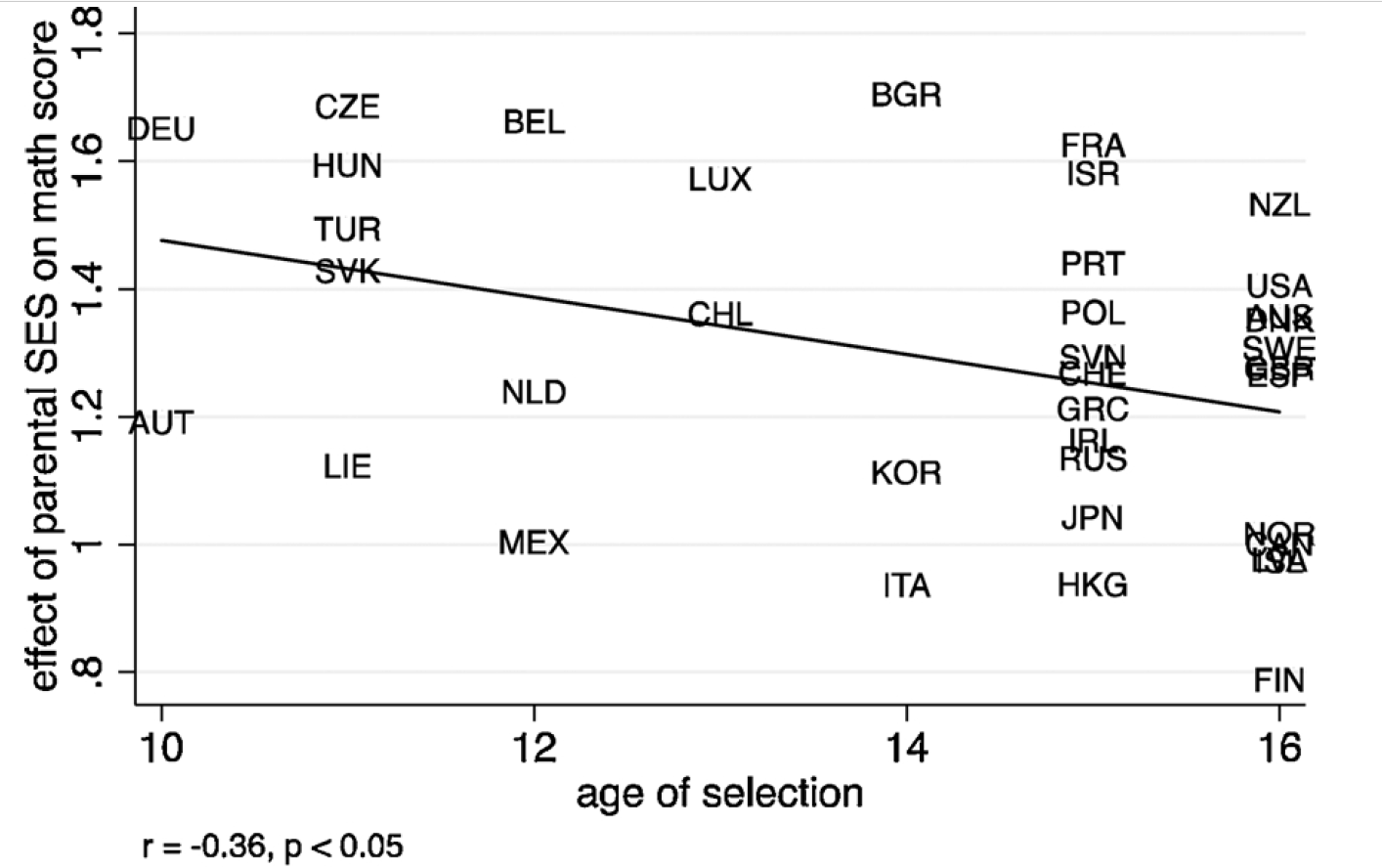 Source: Van der Werfhorst (2018).
Source: Van der Werfhorst (2018).
The above figure only shows a correlation between the extend to which test scores move together with SES and tracking. But: Correlation is no causation! In this case, correlation and causation seem to go in the same direction. In the causal literature on the effects of tracking on inequality there is consensus that tracking increases inequality of opportunity (e.g. Ammermueller, 2004; Schuetz, Ursprung, & Woessmann, 2008; van der Werfhorst, 2018).
But further studies provide nuance to this result. For instance, Brunello & Checchi (2007) find that tracking increases SES effects on formal education outcomes, but that it decreases SES effects on (labor market) outcomes later in life. There is also suggestive evidence that the effect of tracking on SES effects depends on whether ability is explicitly considered when pupils are selected into tracks. Korthals & Dronkers (2016) show correlational (!) evidence that the correlation between tracking and SES effects are weaker in countries where pupils are selected into tracks based on prior performance measures. This makes sense when we consider that in some countries parents can choose to which track their child goes, with well-off parents more often choosing the higher track. If parents have less of an influence on track placement, it seems reasonable that the SES effect on test scores is lower. Other suggestive evidence shows that within tracks, SES effects are lower in tracking countries than in countries with informal tracking (Chmielewski, 2013).
As is often the case, also here some studies do not find that tracking increases the effects of SES on pupil performance (e.g. Walldinger, 2007; Jakubowski, 2010).
Inequality according to migration background
Another important source of inequality in educational opportunities, next to SES, could be migration background. Pupils with a migration background are assumed to be at a disadvantage since they often speak the language less well, their parents have lower SES (although this could be controlled for), their parents know less well how to navigate through the education system and there might be other expectations for these pupils, especially depending on the age of arrival in the country.The figure below shows for age 10 (grade 4 in primary school) and age 14/15 (grade 8/9 in secondary school) the gap between the performance of pupils with foreign born parents but who themselves are born in the host country (second generation migrants) and of native pupils. We see that at both ages the gap is negative, meaning that native pupils perform better than pupils with a migration background. This is the same for reading, mathematics and science.
Figure 2: Average migrant-native achievement gaps in primary and secondary school (click on image to enlarge)
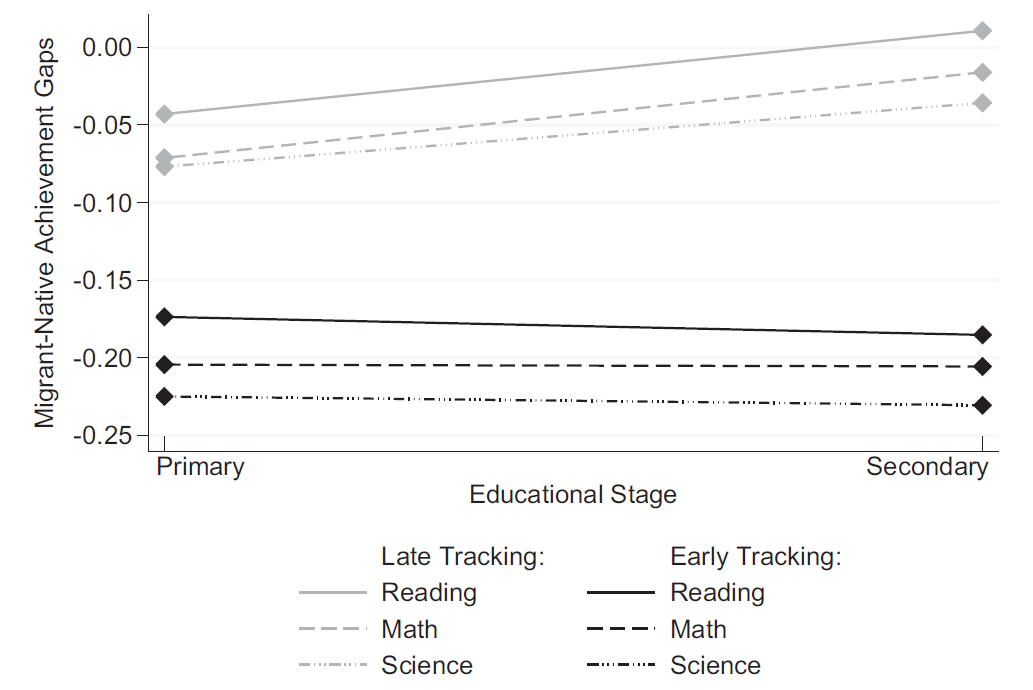 Source: Ruhose & Schwertz (2016).
Source: Ruhose & Schwertz (2016).
In the above figure we also see that for late tracking countries (the light grey lines) the gap declines between the two ages, while for the early trackers (dark grey lines) the gap is larger and the gap stays stable over the years. Ruhose & Schwertz (2016) look at the changes in the migrant-native gap over time in a regression and find that the difference shown in the graph between early and late trackers over time is not significant. Or: early tracking does not increase the gap in test performance between early and late tracking countries. Ammermueller (2004), using a similar but less elaborate method, even finds that having more tracks is positive for pupils with foreign born parents (without making the distinction whether the pupil herself is born abroad or not). Correlational evidence from Cobb-Clark et al. (2012) shows also similar results.
An often-heard reason for this is (no evidence yet!) that in a tracking system the requirements for pupils to get access to the higher tracks are more specific, for instance by performance thresholds, than the more informal social "hoops" pupils have to jump through to gain access to the better schools or better performing classes in non-tracking systems.
Migration status is only one way to look at the migrant-native performance gap. Both Ruhose & Schwertz (2016) and Ammermueller (2004) find that for pupils who do not speak the test language at home, early tracking or more tracks do increase the migrant-native gap over time.
Inequality according to gender
In all countries there is a gender gap in performance. For reading this gender gaps is almost always in favor of the girls. In the 2015 PISA test there was not even a single country where boys performed better than girls in reading (OECD, 2016, Figure I.4.10). On the math test most often boys do better, although certainly not in all countries. For science there is less of a dominant position for boys or girls.The figure below shows the absolute gender gaps in science, reading and mathematics and the number of tracks available to 15-year-olds. There is a small tendency for countries with more advantage for girls to have also more tracks, but this tendency is small and not significant. Thus: At first sight, there seems to be no link between tracking and inequality due to gender.
Figure 3: Gender gap and number of tracks (click on image to enlarge)
(A)
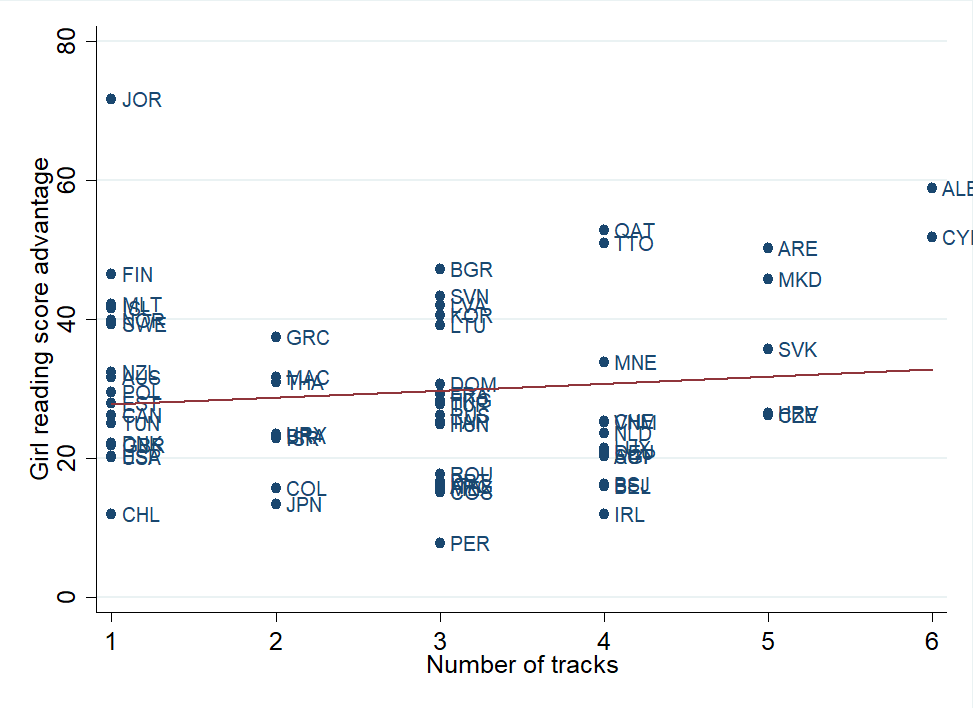 (B)
(B)
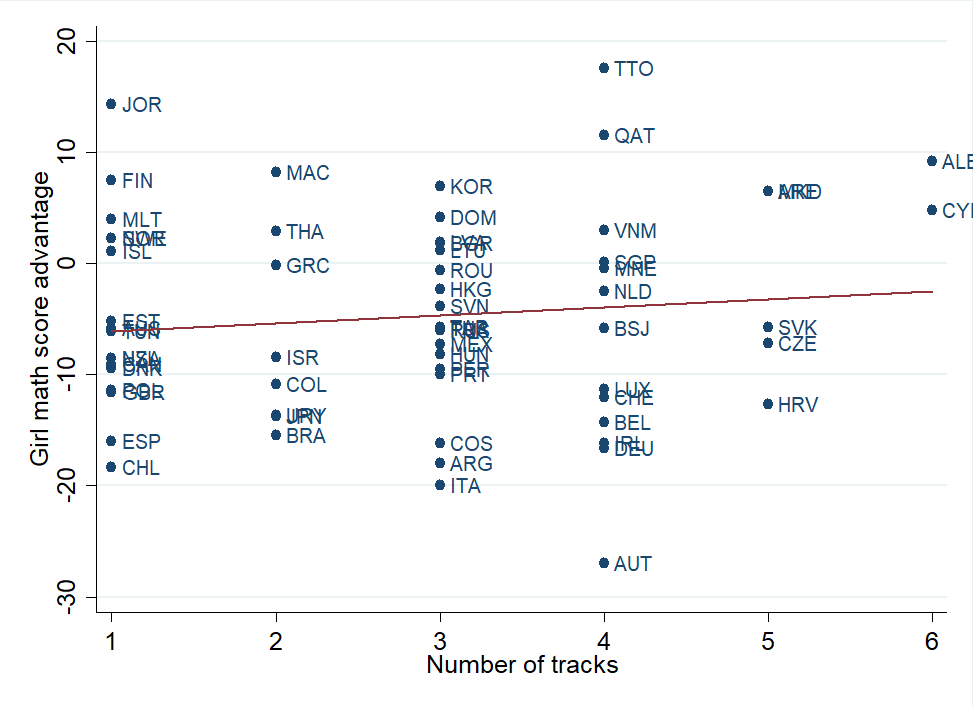 (C)
(C)
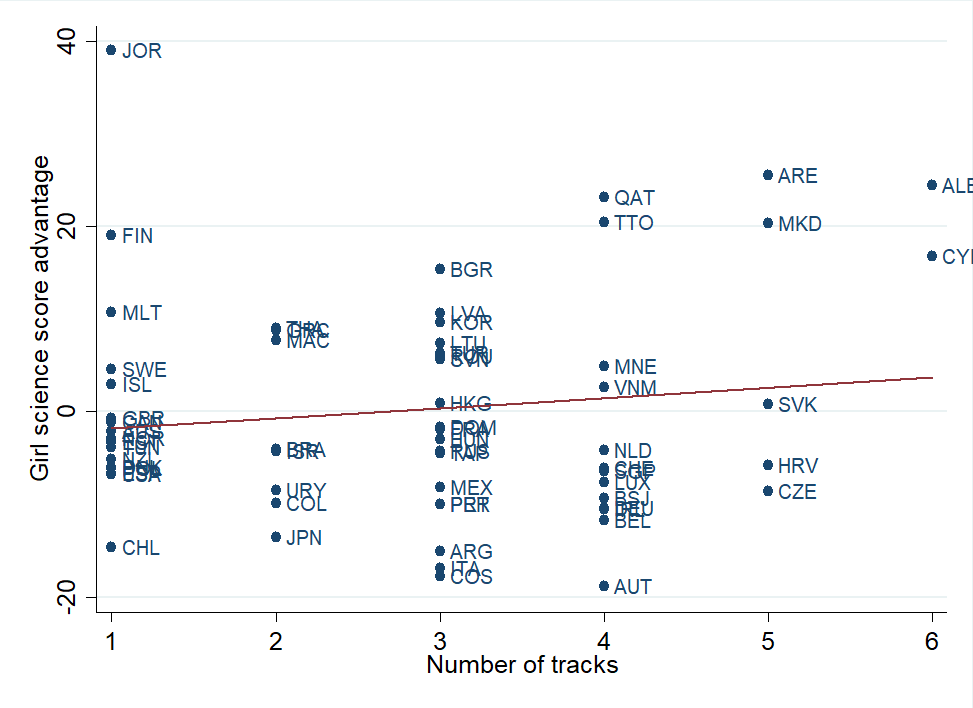 Source: Based on gender gap data from OECD (2016).
Source: Based on gender gap data from OECD (2016).
It is important to note that the figures are made using all countries who participated in PISA 2015. For a sample of 27 countries who have participated in PISA since the start there is a negative significant correlation between the gender gap and the number of tracks in a country.
The usual disclaimer for correlational evidence holds: Even if the correlation was indeed significant, correlation is no causation! A third factor might cause both the better performance of girls and cause countries to have more tracks. Or it could be that countries where girls perform better are more likely to install more tracks.
There are some papers that look at gender inequality related to tracking in other areas that students performance. For instance, a recent paper showed that if tracking happens later, this is beneficial for the completed years of education of girls, as compared to boys (Scheeren et al., 2018). Earlier it was shown that the gender gap in wages (which is in favor of boys) declined after tracking was postponed (Pekkarinen, 2008).
Inequality according to relative age
A final cause of inequality of opportunity which is relevant in a tracking context is the inequality due to relative age. With relative age, I mean the age a pupil has relative to his classmates. In most countries there is a certain cut-off date for when children go to formal schooling for the very first time. Let's say this cut-off is January 1st, which it is in a lot of countries. If you are born before this date, you can enter school this year. If you are born after January 1st, you must wait a year to enroll in school. If all pupils start school at age 6, the older pupils in the class are almost 7 (6 years and 11 months), while the youngest pupils only just turned 6. This 11-month-difference is very large at this age: the older pupils are 15% older! That is the same as comparing 13-year-olds to 15-year-olds!Psychologists have looked at the effects of this 11 months age difference for a very long time. They have found that the relatively young pupils perform worse in a long list of outcomes, among which academic performance (see for an overview Stipek, 2000). The most often mentioned reason to explain the weaker performance of the relatively young pupils is their lower maturity when they start school, or: their lower "school readiness". Most often this age disadvantage disappears over time (Crawford et al., 2010). This "catching up" can be pure mechanical: At age 15 this 11-months-difference is no longer as important as at age 6 (6% younger versus 15% younger). However, it is possible that the early age disadvantage has longer term effects because it might change non-cognitive skills of pupils. For instance, if a pupil is always behind in class in the early years, it might develop lower motivation for school which persists till after the pupil's age disadvantage has disappears.
In a tracking context, there is another way for an early disadvantage to have long term effects. Since relatively young pupils perform less well when the track decision is made, we could expect more relatively young pupils to be placed in the lower tracks. This would be stronger, the earlier a country selects pupils into tracks. Figure 4 below shows per relative age the proportion of pupils that go to the lower track (as opposed to the higher track) in countries that track before the age of 13 and on or after 13. In early tracking countries the difference of going to the lower track between relatively young and relatively old pupils is larger than in late tracking countries (red line is steeper than blie line). Luckily, studies so far do not show (large) long term negative effects of this lower placement (Korthals, 2015; or for Germany only: Dustmann et al., 2014). Still, more research on this topic is needed.
Figure 4: Proportion of pupils going to the low track by relative age for countries that track before or on/after the age of 13 (click on image to enlarge)
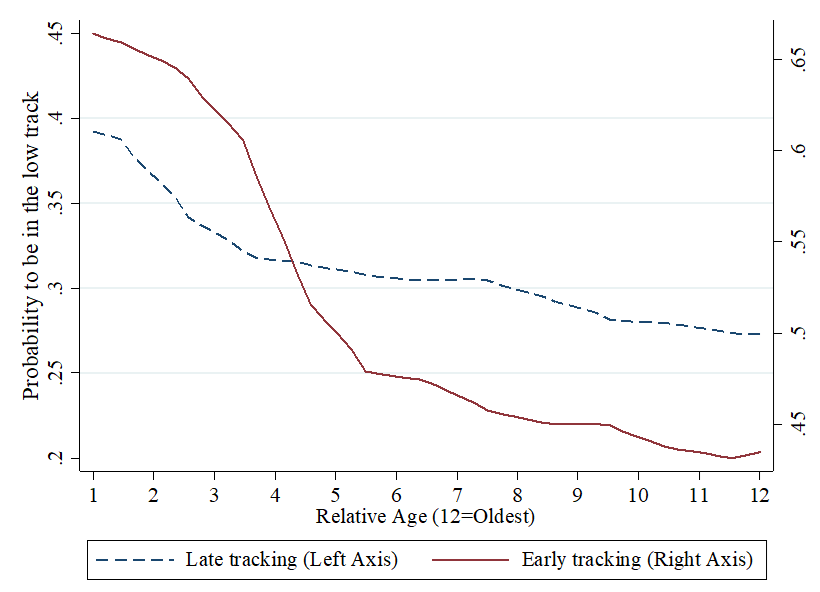 Source: Korthals (2015).
Source: Korthals (2015).
References: pdf